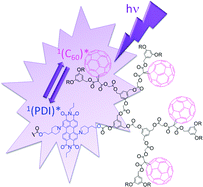Dendritic C60–perylenediimide (PDI) conjugates PerG1–PerG3 have been prepared under esterification conditions starting from a perylene diol building block (Per) and fullerodendrons bearing a carboxylic acid function at the focal point. The cyclic voltammograms recorded for PerG1–PerG3 show the characteristic electrochemical features of both constitutive units, i.e.methanofullerene and PDI. The comparison with the corresponding model compounds (Per and F) shows that the oxidation of the dendrimers is centered on the PDI core, while the first reduction corresponds to a fullerene-centred process. The photophysical properties of PerG1–PerG3 and of the related reference systems Per and F were investigated in toluene solution. Per and F exhibit almost superimposed fluorescence bands sitting across the Vis and NIR spectral regions, showing that the corresponding singlet states are virtually isoenergetic (∼1.75 eV). The two bands are characterized by very different fluorescence quantum yields and short singlet lifetimes; Per: Φfluo = 7.8%, τ = 3.7 ns; F: Φfluo = 0.04%, τ = 1.8 ns. In the dendrimers, the isoenergetic singlet levels of the PDI and fullerene moieties lead to a very peculiar luminescence behaviour that is invariably found regardless of the excitation wavelength. The detected fluorescence band in PerG1–PerG3 has always the shape of the PDI central core, reduced in intensity by about 20 times compared to Per, whilst the lifetime is that of the peripheral fullerene unit. At 298 K, this unconventional behaviour is interpreted by a kinetic model involving fast equilibration of the singlet levels separated by about 0.06 eV, the PDI-centred level being the highest one. At 77 K the equilibration is suppressed and the fluorescence of the PDI central core is fully restored, showing that the corresponding level becomes lower-lying than the fullerene singlet. Bimolecular transient absorption studies made on solutions containing F and Per show that triplet energy transfer from the photoexcited fullerene to the PDI occurs. Similar investigations on PerG1–PerG3 only exhibit the features of the PDI triplet, evidencing that this level is populated in a timescale shorter than 10 ns and is the final sink of the above lying excited states. Therefore, in dendrimers PerG1–PerG3, the photophysical behaviour is not dependent on the dendrimer size and structure, and light excitation is followed by inbound energy transfer to the central core and generation of the PDI triplet state.

You have access to this article
 Please wait while we load your content...
Something went wrong. Try again?
Please wait while we load your content...
Something went wrong. Try again?


 Please wait while we load your content...
Please wait while we load your content...